





The transformation of concrete into decorative concrete is achieved through the use of a variety of materials that may be applied during the pouring process or after the concrete is cured, these materials and/or systems include but are not limited to stamped concrete, acid staining, decorative overlays, polished concrete, concrete countertops, vertical overlays and more.
Concrete is one of the most durable and versatile construction products ever developed, and is more widely used than any other building material. Modern finishing methods have expanded the uses of concrete to include products such as kitchen countertops and finished interior flooring. Typical exterior projects such as driveways and patios have been transformed into realistic stone and brick designs that are more durable than the real thing.
Stamped concrete is the process of adding texture and color to concrete to make it resemble stone, brick, slate, cobblestone and many other products found in nature including wood, fossils, shells and many more. This limitless array of possibilities combined with great durability and lower cost than natural products makes Stamped Concrete an easy choice for new construction and renovation projects.
The installation consists of pressing molds into the concrete while the concrete is still in its plastic state. Color is achieved by using Dry Shakes or Color Hardeners, Powder or Liquid Releases, Integral Colors or Acid Stains. All these products may be combined to create even more intricate designs.
Click for examples of stamped concrete from Osnes Enterprises
It's not stamped. It's not a topping or an overlay. It's cutting patterns into plain or decoratively-stained concrete. Sometimes the engraving happens first, and then individual elements are hand-stained for stunning effects.
Existing concrete can be remodeled by cutting lines and grooves into its surface. Geometric patterns, straight or curved lines and custom designs can be cut directly into the surface of the concrete creating the look of tile, flagstone, cobblestone and many other common surface patterns. This is usually achieved using tools like an angle grinder fitted with diamond blades, but is more effectively accomplished using specialty tools designed specifically for cutting designs into the concrete.
Click for examples of concrete engraving from Osnes Enterprises
Acid staining is not a dyeing or pigment-base coloring systems, but a chemical reaction. A mixture of water, mineral salts and a slight amount of muratic acid is applied to the concrete surface. This chemical reaction with the existing minerals (primarily lime) in the concrete over a period of one to four hours creates new earth tone colors on the concrete surface. The concrete surface is later scrubbed to remove excess stain and neutralized by a basic solution of ammonia and water or baking soda (less likely to cause whiting later) to help raise the ph level back to normal level. Due to inconsistencies in the surface level of concrete floor, acid staining creates a variegated or mottled appearance that is unique to each slab. The color penetration ranges from 1/16 to 1/32 of an inch.
Click for examples of acid stained concrete from Osnes Enterprises




